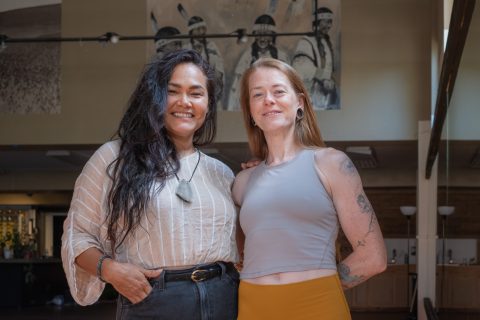Farmworkers, food processors a focus for COVID-19 vaccination
Published 3:09 pm Monday, April 5, 2021

- Cars navigate a COVID-19 mass vaccination site at the Sage Center in Boardman on Wednesday, March 24, 2021.
After the Oregon Health Authority (OHA) announced in May 2020 that the agency would start publishing weekly lists of workplace outbreaks of COVID-19, it became clear that agricultural workers were at high risk for catching the virus on the job. A majority of the outbreaks on the early lists were made up of food processing plants, farms and trucking companies.
Now, in the spring of 2021, Eastern Oregon counties with large agricultural bases are working hard to prevent a repeat of last summer by getting workers up and down the agricultural supply chain vaccinated as quickly as possible.
Trending
In Morrow County, County Commissioner Melissa Lindsay said she fears farmworkers became eligible in Oregon about two weeks too late to prevent outbreaks during the spring planting season. But once the county was given approval to start vaccinating farmworkers and those in food processing, it worked hard to make up for lost time.
Two days after getting approval to open vaccination to agricultural workers on March 22, the county partnered with the OHA in a pilot project that included hosting a four-day drive-thru vaccine clinic with available times ranging from 7 a.m. to 8 p.m. to try to accommodate as many work schedules as possible. No appointments were necessary.
“It’s gone very smoothly, and we’re very pleased with OHA’s assistance,” Lindsay said.
She said she pushed the state to provide the one-dose Johnson & Johnson vaccine so that workers didn’t have to be worried about missing work to get vaccinated twice or deal with possible post-vaccine symptoms a second time.
The county also created a sign-up at the beginning of the year for all residents interested in getting a call letting them know when they become eligible. Lindsay said that list has been helpful for outreach. She also said Morrow County has been trying to get large workplaces to let them come in and administer vaccines on site, but has had less willingness on that than she had hoped.
In neighboring Umatilla County, Health Director Joe Fiumara also said that the county has not had a “great acceptance rate” so far from employers letting the county bring vaccines directly to their employees.
Trending
“We’re trying to bring (the vaccine) to the worksite to reduce some of the barriers,” he said. “We’re hearing it don’t work for a lot of people to take time off work to go to a vaccine clinic and maybe lose two hours of pay.”
However, Fiumara said he has been pleasantly surprised by how many farmworkers have said they don’t need the vaccine because they already got it. Some had scheduled an appointment through Mirasol Family Health Center in Hermiston, which was allowed to start vaccinating farmworkers early under a separate federal program, while others qualified through other means such as through Veterans Affairs, the Confederated Tribes of the Umatilla Indian Reservation or by traveling out of state.
In most of those cases, Fiumara said vaccinations are reported directly to the Centers for Disease Control and Prevention, without being reported to the county. So Umatilla County Public Health isn’t completely sure what the true vaccination rate is among residents.
“I don’t think we’re covered as well as we’d like to be, but I think we’re covered better than the data might be showing,” he said.
Like Lindsay, Fiumara said agricultural workers seemed to prefer the Johnson & Johnson shot, and he has seen some cases where workers are only willing to take that particular brand of vaccine. The county, which has mostly been giving out the Moderna vaccine, which requires two doses over a month, will be receiving an order of 1,000 Johnson & Johnson doses soon.
To the east of Umatilla County, Carrie Brogoitti, Public Health Administrator for the Union County Center for Human Development, said Union County has worked hard to provide information about vaccines in “all languages spoken in the county.” That includes not only English and Spanish, but also brochures, fliers and informational phone lines with help in Chuukese, Marshallese, Palauan and Pohnpeian.
“We’re doing everything we can to reach every person in the community, and that includes agricultural workers,” she said. “We’re using social media, we’re using the newspaper, we’re using radio.”
Brogoitti said a big key to that effort has been partnering with trusted community-based organizations, such as Euvalcree and Northeast Oregon Network. Those organizations helped develop a consistent set of outreach materials for everyone to use, help spread information by word of mouth, and know how to help people get signed up for a vaccine appointment without having to refer them to the health department for help.
“We have a ‘no wrong door’ approach,” she said.
Teresa Aguilar, an outreach and enrollment specialist for Northeast Oregon Network, is one of those people who spends time on the phone helping people get signed up for a vaccine appointment. If they have a language barrier or are having trouble accessing the online portal, she can input their information for them before giving them the date and time to show up.
“There’s not just a language barrier, for some folks, there’s a technology barrier,” she said.
Not all Eastern Oregon counties are as heavily agricultural. Holly Kerns, a public information officer for Baker County, said the county, although it has many farms and ranches, doesn’t have the food processing plants, dairies and large farms that a county like Morrow County does, so it doesn’t make as much sense to bring the vaccine to agricultural worksites. In Baker County most farms and ranches have just a handful of employees, the “vast majority” of whom are fulltime residents, Kerns said.
Still, she said there are plenty of opportunities for agricultural workers to get vaccinated, through local clinics and pharmacies.









